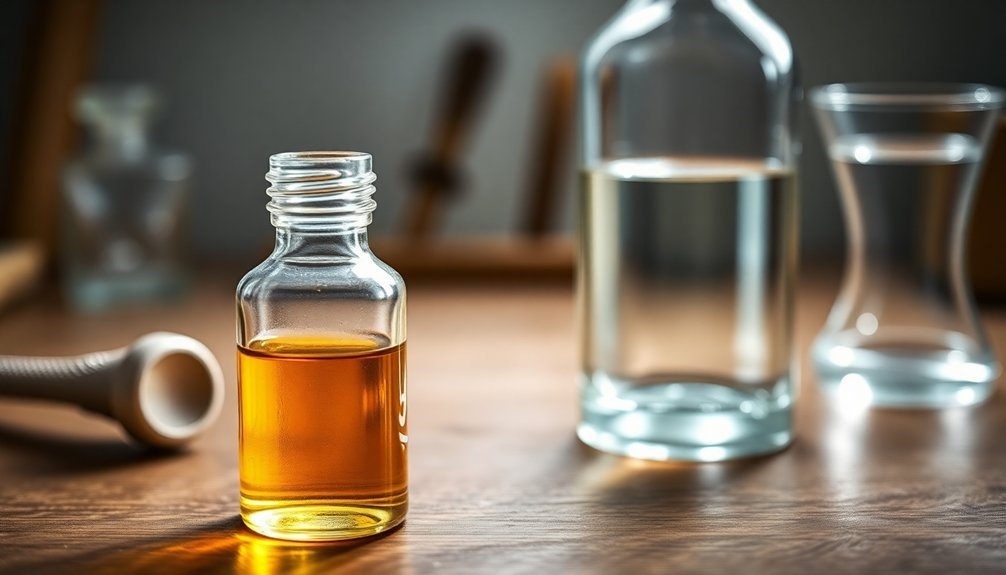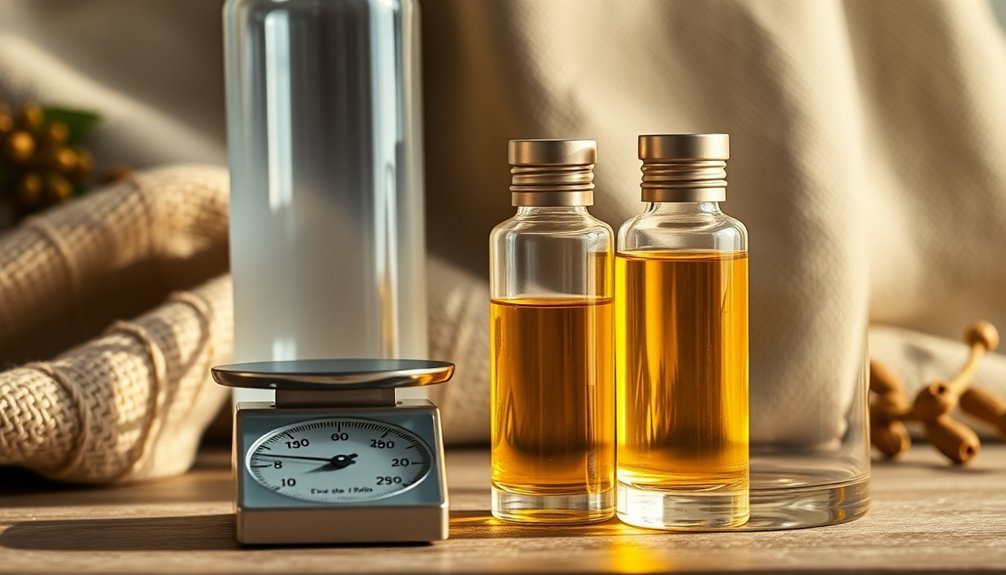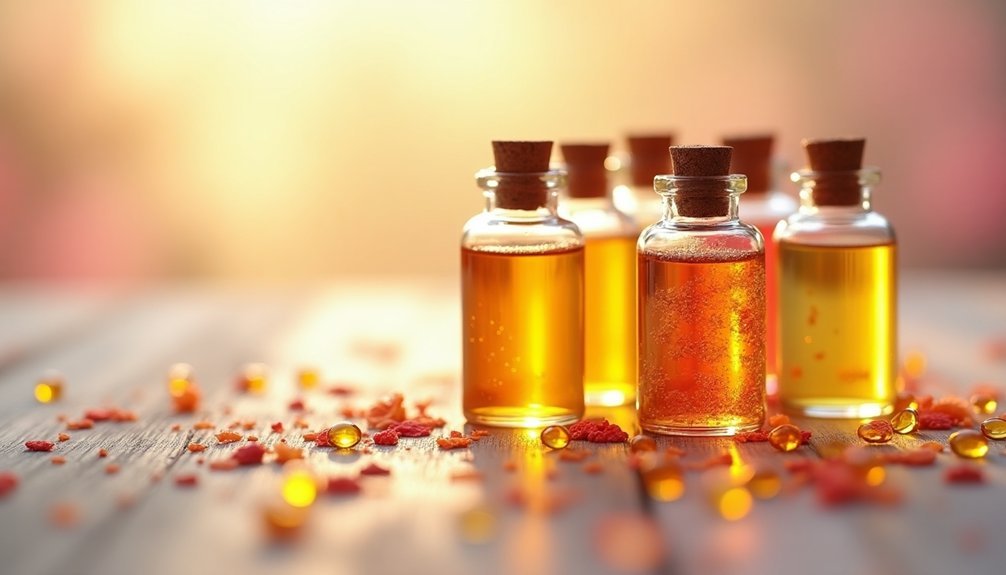When making perfumes, you'll want to follow these seven proven dilution ratios: Standard perfume oils need 20-30% oil to alcohol, light body sprays work best at 10-15% with DPG, eau de parfum requires 15-25% with ethanol, essential oil blends use 1-3% with carrier oils, professional grade perfumes demand 30-40% oil content, room fragrances need just 0.5-1% with isopropanol, and synthetic fragrances perform at 5-10% with perfumer's alcohol. Understanding these ratios will reveal your potential for creating signature scents.
Standard Perfume Oil (20-30%) to Perfumer's Alcohol

Creating a standard perfume requires precise dilution of fragrance oils with perfumer's alcohol.
You'll want to maintain a ratio of 20-30% essential or fragrance oils to 80-70% perfumer's alcohol for ideal results. This concentration range delivers a strong scent while minimizing the risk of skin reactions.
For a 10ml atomizer bottle, you'll need about 40 drops of essential oils (20%) mixed with 140 drops of alcohol. If you're aiming for a stronger fragrance, you can increase the oil content up to 30%, but don't exceed this limit to avoid potential allergic responses.
Always use pure undenatured ethanol as your perfumer's alcohol – it evaporates quickly and won't alter your scent profile. Using a jewellery scale for measurements will ensure more accurate and repeatable results than counting drops. While you can add distilled water, it's optional and may create cloudiness in your final product.
Light Body Spray Formula (10-15%) to DPG
Three key ingredients form the foundation of a light body spray: fragrance oil, DPG (Dipropylene Glycol), and optional additives.
For a light body spray formula, you'll want to aim for a 10-15% fragrance concentration, with DPG serving as your primary diluent. DPG helps maintain the scent profile while supporting proper evaporation. Professional perfumers suggest avoiding fixatives and stabilizers as they may interfere with the natural development of the scent.
When creating your formula, consider these essential ratios:
- Use 10-15% fragrance oil (100-150ml per 1000ml final product)
- Add DPG as your main diluent (approximately 70-80% of the mixture)
- Include optional additives like propylene glycol or distilled water (5-10%)
To mix properly, weigh your ingredients accurately using a scale rather than measuring by drops.
Let your mixture mature for several hours before use to achieve the ideal scent profile.
Concentrated Eau De Parfum (15-25%) to Ethanol

When formulating a concentrated Eau de Parfum, achieving the right balance between perfume oils and ethanol is essential for ideal performance.
You'll want to aim for 15-20% perfume oils mixed with about 85% ethanol and distilled water to create a fragrance that lasts 4-5 hours on the skin.
Start by mixing your concentrated perfume oils with ethanol, which has a specific gravity of 0.8. The ethanol helps make your oils volatile and creates that initial splash sensation upon application.
You'll need to store your mixture in amber or cobalt blue bottles to protect it from light degradation.
Remember that while concentration matters, the quality of your raw materials will also influence the final fragrance's strength and sillage. This formulation provides a balanced strength and cost compared to other fragrance concentrations.
Essential Oil Blend (1-3%) to Carrier Oil
When working with essential oils, you'll need to follow proper dilution ratios of 1-3% with carrier oils to protect your skin and prevent adverse reactions.
You can achieve precise measurements by using 3-12 drops of essential oil per ounce of carrier oil, depending on your desired concentration and intended use.
For facial applications, keep the dilution at 1% or less, while body care products can safely use up to 2% essential oil concentration.
Safety First Dilution Guidelines
Since necessary oils are highly concentrated plant extracts, proper dilution with carrier oils isn't just a suggestion – it's a crucial safety requirement.
For most body care applications, you'll want to stick to a 2% dilution ratio, which means about 12-18 drops of essential oil per ounce of carrier oil.
To guarantee safe usage, follow these key guidelines:
- Always start with less essential oil than you think you need – you can add more later
- Conduct a patch test before applying any new blend to larger areas
- Use dilution charts to calculate exact measurements for your specific project
For sensitive skin, reduce the concentration to 1%.
Remember that different essential oils have varying potencies, so research each oil's specific requirements before creating your blend.
Measuring For Precise Blends
Building on safe dilution practices, accurate measurements create the foundation for successful fragrance blends. You'll need to understand precise ratios when working with essential oils and carrier oils. For a standard 2% dilution, use a scale rather than counting drops, as it provides more consistent results.
| Amount | Carrier Oil | Essential Oil (2%) |
|---|---|---|
| 10ml | 9.8ml | 0.2ml (4 drops) |
| 30ml | 29.4ml | 0.6ml (12 drops) |
| 50ml | 49ml | 1ml (20 drops) |
| 100ml | 98ml | 2ml (40 drops) |
Remember that 1ml equals approximately 20 drops, but this can vary based on the oil's viscosity. When you're creating custom blends, start with these basic measurements and adjust according to your specific fragrance requirements while maintaining the safe dilution percentage.
Skin Application Tips
Three essential principles guide safe skin application of essential oil blends: proper dilution, carrier oil selection, and careful mixing.
When applying essential oils to your skin, you'll need to achieve the right dilution ratio based on your specific needs and skin sensitivity.
For most adults, follow these key guidelines:
- Use a 1-3% dilution ratio (12-18 drops per 30ml carrier oil for 2% dilution)
- Choose carrier oils that match your skin type – grapeseed for oily skin, jojoba for dry skin
- Avoid nut-based carriers if you have allergies, opting instead for alternatives like fractionated coconut oil
Remember to mix your oils thoroughly before application, and always perform a patch test when trying new blends.
For facial applications, stick to a lower 1.25% dilution ratio, using about 5 drops per 20ml of carrier oil.
Professional Grade Perfume (30-40%) to Alcohol Base
When creating professional-grade perfumes with 30-40% concentration, you'll need to precisely measure your fragrance oils and alcohol base to achieve the desired strength. Use a scale rather than counting drops to guarantee accuracy, and always choose proper perfumer's alcohol as your diluent.
| Concentration | Fragrance Oils | Alcohol Base |
|---|---|---|
| 30% Formula | 30ml oils | 70ml alcohol |
| 35% Formula | 35ml oils | 65ml alcohol |
| 40% Formula | 40ml oils | 60ml alcohol |
Remember that higher concentrations can increase the risk of skin irritation, so it's vital to perform patch tests before finalizing your formula. You'll want to let your perfume mature after mixing to allow the scents to blend properly. While these concentrations are stronger than commercial fragrances, they'll give you a professional-grade product with excellent longevity and projection.
Room Fragrance Mix (0.5-1%) to Isopropanol

Creating room fragrances requires markedly lower concentrations than personal perfumes, typically ranging from 0.5% to 1% fragrance oils mixed with isopropanol.
While you might be tempted to use higher concentrations, staying within this range helps prevent overpowering scents and guarantees peak performance. The isopropanol base helps solve solubility issues and promotes quick evaporation for better fragrance distribution.
When mixing your room fragrance, keep these key points in mind:
- Use a fine-mist spray nozzle to improve scent distribution and prevent floor wetting
- Add water gradually if needed, but remember it can cause fogging and stability issues
- Monitor the isopropanol concentration as it affects both performance and safety labeling requirements
This low-concentration formula delivers effective room freshening while maintaining product stability and compliance with safety regulations.
Potent Synthetic Fragrance (5-10%) to Perfumer's Alcohol
Synthetic fragrances demand a higher dilution ratio of 5-10% in perfumer's alcohol to achieve ideal potency and skin safety. This concentration range lets you create strong, lasting scents while minimizing the risk of skin irritation or allergic reactions.
When you're working with synthetic fragrances, you'll want to use pure perfumer's alcohol (ethanol) as your solvent. It's superior to denatured alcohol because it doesn't contain additives that might alter your fragrance profile.
For everyday perfumes, stick to a 5% dilution, while you can push to 10% for more intense creations.
Always measure your ingredients by weight rather than drops to guarantee consistency. Before applying any new blend, don't forget to perform a patch test, as some synthetic fragrances may require lower concentrations depending on their specific potency.
Frequently Asked Questions
How Long Should Fragrance Oils Be Aged Before Diluting Them?
You'll want to pre-age your fragrance oils for 4 days on average, though you can extend this to a week. Store them in a dark bottle in a cool place for best results.
Can I Mix Different Types of Diluents for a Single Perfume?
You shouldn't mix different diluents in a single perfume. It can cause instability, separation, and inconsistent fragrance release. Stick to one type of diluent – either alcohol-based or oil-based – for best results.
What Temperature Should I Maintain While Diluting Fragrance Oils?
You'll want to maintain room temperature (68-72°F) when diluting fragrance oils. Don't heat them, as it can alter their chemical composition. Keep your workspace cool and avoid direct sunlight while mixing.
Does the Dilution Ratio Change for Vintage Versus Modern Fragrance Materials?
Yes, you'll need different dilution ratios. Vintage materials are often stronger and more concentrated, requiring less dilution, while modern synthetic materials typically need higher dilution ratios to achieve similar effects in your blends.
How Do Seasonal Temperature Changes Affect Perfume Dilution Ratios?
You'll need higher dilution ratios in summer since heat intensifies fragrances. In winter, use lower dilution ratios as cold temperatures slow down evaporation and scent projection, requiring stronger concentrations for ideal performance.
In Summary
Now you're equipped with the essential dilution ratios for your fragrance-making journey. Remember to start with lower concentrations and adjust based on your desired strength. Whether you're creating a personal perfume or room spray, these ratios will help you achieve professional results. Always measure precisely and test small batches before scaling up. Keep experimenting until you find your perfect blend.





Leave a Reply